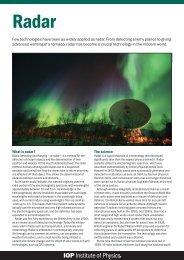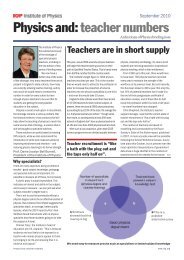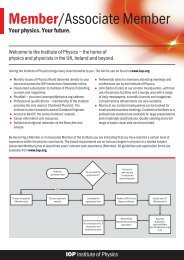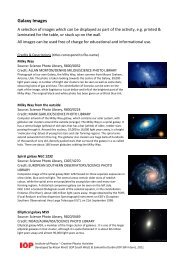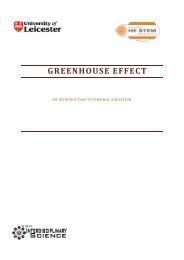Digital Scatter Removal in Mammography to enable Patient Dose ...
Digital Scatter Removal in Mammography to enable Patient Dose ...
Digital Scatter Removal in Mammography to enable Patient Dose ...
Create successful ePaper yourself
Turn your PDF publications into a flip-book with our unique Google optimized e-Paper software.
Medical Physics and Cl<strong>in</strong>ical Eng<strong>in</strong>eer<strong>in</strong>g<br />
<strong>Digital</strong> <strong>Scatter</strong> <strong>Removal</strong> <strong>in</strong><br />
<strong>Mammography</strong><br />
<strong>to</strong> <strong>enable</strong> <strong>Patient</strong> <strong>Dose</strong> Reduction<br />
Mary Cocker<br />
Radiation Physics and Protection<br />
Oxford University Hospitals NHS Trust<br />
Chris Tromans, Mike Brady<br />
University of Oxford
Medical Physics and Cl<strong>in</strong>ical Eng<strong>in</strong>eer<strong>in</strong>g<br />
Aims of talk<br />
<strong>Scatter</strong> <strong>in</strong> <strong>Digital</strong> <strong>Mammography</strong><br />
Overview of scatter removal algorithm<br />
Advantages over current techniques<br />
Validation us<strong>in</strong>g phan<strong>to</strong>ms and cl<strong>in</strong>ical mammography<br />
equipment<br />
Conclusions
Medical Physics and Cl<strong>in</strong>ical Eng<strong>in</strong>eer<strong>in</strong>g<br />
<strong>Scatter</strong> <strong>in</strong> <strong>Digital</strong> <strong>Mammography</strong><br />
<strong>Scatter</strong>ed pho<strong>to</strong>ns arise from pho<strong>to</strong>n <strong>in</strong>teraction with breast tissue<br />
<strong>Scatter</strong> reach<strong>in</strong>g digital image detec<strong>to</strong>r reduces image contrast<br />
Causes systematic low frequency blurr<strong>in</strong>g of primary image<br />
Grid is therefore used <strong>to</strong> absorb and remove scatter<br />
Grid attenuates primary fluence.<br />
However….<br />
Increase mA and breast dose for effective image quality.<br />
<strong>Scatter</strong> algorithm can be utilised by <strong>Digital</strong> Imag<strong>in</strong>g <strong>in</strong>stead of a grid
Medical Physics and Cl<strong>in</strong>ical Eng<strong>in</strong>eer<strong>in</strong>g<br />
<strong>Scatter</strong> Algorithm<br />
<strong>Scatter</strong> algorithm is an <strong>in</strong>tegral part of an efficient model <strong>to</strong><br />
calculate tissue densities similar <strong>to</strong> CT Hounsfield units.<br />
Efficient model:<br />
1. Model of pho<strong>to</strong>n energy spectrum (based on Cranley et al)<br />
2. Ray tracer algorithm <strong>to</strong> obta<strong>in</strong> energy exit<strong>in</strong>g the breast.<br />
Accounts for diverg<strong>in</strong>g beam and <strong>in</strong>cludes model of breast<br />
tissue attenuation.<br />
3. <strong>Scatter</strong> algorithm used <strong>to</strong> subtract scatter component.<br />
4. Model of image detec<strong>to</strong>r <strong>in</strong>corporat<strong>in</strong>g l<strong>in</strong>ear transfer<br />
functions.
Medical Physics and Cl<strong>in</strong>ical Eng<strong>in</strong>eer<strong>in</strong>g<br />
Overall model:<br />
Standard Attenuation Rate (SAR)<br />
SAR at an image location x,y:<br />
s x,y is scatter<br />
SARx,y = mx,yln(D-1 SARx,y = mx,yln(D (I (Ix,y) x,y) – s sx,y) x,y) + c x,y<br />
D(i) is detec<strong>to</strong>r calibration transfer function relat<strong>in</strong>g recorded<br />
pixel <strong>in</strong>tensity, i, <strong>to</strong> <strong>to</strong>tal pho<strong>to</strong>n energy absorbed by pixel<br />
detec<strong>to</strong>r<br />
m x,y and c x,y are dependant on spatial location x,y
Medical Physics and Cl<strong>in</strong>ical Eng<strong>in</strong>eer<strong>in</strong>g<br />
<strong>Scatter</strong> Algorithm<br />
Builds on fundamental physical relations underly<strong>in</strong>g Monte Carlo<br />
Uses optimal <strong>in</strong>formation sampl<strong>in</strong>g and <strong>in</strong>terpolations<br />
Iterative ref<strong>in</strong>ement <strong>to</strong> calculate radiodensity and scatter field<br />
<strong>Scatter</strong> kernels around primary ray comb<strong>in</strong>ed <strong>to</strong> give scatter<br />
image.<br />
Considers: Beam quality, position <strong>in</strong> field, presence of grid<br />
Result:<br />
Efficient scatter removal software which will run on any cl<strong>in</strong>ical<br />
system.
Medical Physics and Cl<strong>in</strong>ical Eng<strong>in</strong>eer<strong>in</strong>g<br />
<strong>Scatter</strong> Algorithm<br />
<strong>Scatter</strong> = Superpose(Primary(x),I detec<strong>to</strong>r(x))<br />
Superpose is non-l<strong>in</strong>ear. Accounts for breast periphery.<br />
I detec<strong>to</strong>r(x) is the spatially vary<strong>in</strong>g local scatter function which is<br />
<strong>in</strong>terpolated us<strong>in</strong>g small set of image locations.<br />
Ability <strong>to</strong> use this algorithm <strong>in</strong> forward simulation, i.e. <strong>to</strong> model<br />
the scatter reach<strong>in</strong>g image detec<strong>to</strong>r
Medical Physics and Cl<strong>in</strong>ical Eng<strong>in</strong>eer<strong>in</strong>g<br />
<strong>Scatter</strong><br />
kernels<br />
length c<br />
A<br />
P<br />
dt<br />
Primary Beam<br />
B C<br />
<strong>Scatter</strong> Path, length r<br />
Division of primary ray <strong>in</strong><strong>to</strong> a number of sampled po<strong>in</strong>ts, p.<br />
Sum the scatter from each po<strong>in</strong>t <strong>to</strong> get scatter kernels.<br />
Sum scatter kernels <strong>to</strong> get scatter image.<br />
Efficient ray-tracer calculates tissues traversal distances us<strong>in</strong>g<br />
fundamental scatter relations.<br />
Attenuation p <strong>to</strong> C accord<strong>in</strong>g <strong>to</strong> pho<strong>to</strong>electric absorption<br />
Breast<br />
Image Pixel
Medical Physics and Cl<strong>in</strong>ical Eng<strong>in</strong>eer<strong>in</strong>g<br />
Validation
Medical Physics and Cl<strong>in</strong>ical Eng<strong>in</strong>eer<strong>in</strong>g<br />
Validation of model<br />
Various phan<strong>to</strong>ms designed and built<br />
Imag<strong>in</strong>g carried out on standard digital<br />
unit used <strong>in</strong> NHS hospital:<br />
<strong>Digital</strong> <strong>Mammography</strong> X-ray Unit<br />
GE Senographe Essential<br />
Oxford Breast Imag<strong>in</strong>g Centre<br />
Image detec<strong>to</strong>r:<br />
aSi, 24 x 31 cms, pixel size 100μm
Medical Physics and Cl<strong>in</strong>ical Eng<strong>in</strong>eer<strong>in</strong>g<br />
<strong>Scatter</strong> kernels<br />
Shape of scatter kernels confirmed by us<strong>in</strong>g<br />
Pb apertures over scatter<strong>in</strong>g medium.<br />
Variation <strong>in</strong> signal with aperture<br />
depends on angular scatter<strong>in</strong>g<br />
and attenuation.<br />
Results:<br />
Max. 5% error us<strong>in</strong>g 70mm<br />
aperture<br />
Breast equivalent<br />
PMMA attenua<strong>to</strong>rs<br />
70mm lead aperture<br />
Lead segrega<strong>to</strong>r<br />
Lead l<strong>in</strong>ed box
Medical Physics and Cl<strong>in</strong>ical Eng<strong>in</strong>eer<strong>in</strong>g<br />
Contrast and Noise<br />
Sharp vertical discont<strong>in</strong>uity phan<strong>to</strong>m<br />
Adipose and fibroglandular tissue<br />
equivalents<br />
Contrast = mean(bgd) – mean(object)<br />
mean(bgd)<br />
CNR = mean(bgd) – mean(object)<br />
√<br />
(Young et al, BJR, 2006)<br />
(sd(bgd) 2 + sd(object) 2 )<br />
2<br />
X100%<br />
29kVp Mo-Rh<br />
71mAs without<br />
an anti-scatter<br />
grid<br />
CIRS phan<strong>to</strong>m
Medical Physics and Cl<strong>in</strong>ical Eng<strong>in</strong>eer<strong>in</strong>g<br />
Bucky/grid fac<strong>to</strong>r effect on CNR<br />
Good CNR image without<br />
grid, processed with scatter<br />
algorithm<br />
Poor CNR image<br />
without grid <strong>Dose</strong> sav<strong>in</strong>g of<br />
~37% can be<br />
achieved and still<br />
ma<strong>in</strong>ta<strong>in</strong> CNR.
Medical Physics and Cl<strong>in</strong>ical Eng<strong>in</strong>eer<strong>in</strong>g<br />
<strong>Dose</strong> Reduction<br />
The discont<strong>in</strong>uity phan<strong>to</strong>m shows that the CNR for the<br />
scatter model images rema<strong>in</strong>s superior <strong>in</strong> the<br />
absence of a grid.<br />
By us<strong>in</strong>g the scatter model a reduction <strong>in</strong> mAs from 71<br />
<strong>to</strong> 45 can be achieved before CNR is compromised.
Medical Physics and Cl<strong>in</strong>ical Eng<strong>in</strong>eer<strong>in</strong>g<br />
Step wedge test phan<strong>to</strong>m<br />
Tissue equivalent step wedge phan<strong>to</strong>m.<br />
Adipose and fibroglandular tissues.<br />
Actual Simulation
Medical Physics and Cl<strong>in</strong>ical Eng<strong>in</strong>eer<strong>in</strong>g<br />
Cl<strong>in</strong>ical phan<strong>to</strong>m evaluation<br />
Tissue equivalent phan<strong>to</strong>m – CIRS BR3D<br />
Mimics cl<strong>in</strong>ically realistic heterogeneous breast tissue<br />
Conta<strong>in</strong>s microcalcifications, fibrils, masses
Medical Physics and Cl<strong>in</strong>ical Eng<strong>in</strong>eer<strong>in</strong>g<br />
Cl<strong>in</strong>ical Phan<strong>to</strong>m images<br />
Subtract ‘without grid’ images from ‘with grid’ images<br />
Subtraction image shows solely random noise with<strong>in</strong> 95%<br />
confidence limits.<br />
Worst case occurs for Rhodium anode where focal spot<br />
position is different. Requires 2 pixel translation.<br />
Mo anode<br />
Rh anode
Medical Physics and Cl<strong>in</strong>ical Eng<strong>in</strong>eer<strong>in</strong>g<br />
Conclusions<br />
• <strong>Scatter</strong> algorithm can be computed <strong>in</strong> a cl<strong>in</strong>ically realistic<br />
computation time.<br />
Time <strong>to</strong> compute ~35 secs with parallelisation techniques.<br />
• Differences between actual and simulated pixel <strong>in</strong>tensities <strong>in</strong><br />
breast tissue is:<br />
2.1% with grid<br />
3.4% without grid.<br />
• <strong>Scatter</strong> model can res<strong>to</strong>re image quality <strong>in</strong> absence of grid<br />
and at ~40% reduction <strong>in</strong> dose.<br />
• Improved image quality is possible without hav<strong>in</strong>g <strong>to</strong> <strong>in</strong>crease<br />
dose.
Medical Physics and Cl<strong>in</strong>ical Eng<strong>in</strong>eer<strong>in</strong>g<br />
Thank You<br />
Acknowledgements:<br />
Oxford Breast Imag<strong>in</strong>g Centre









